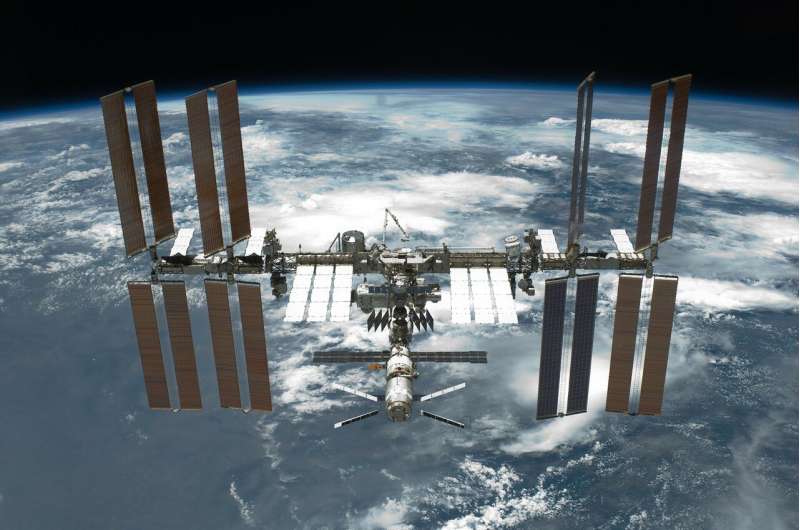This article has been reviewed according to Science X's editorial process and policies. Editors have highlighted the following attributes while ensuring the content's credibility:
fact-checked
reputable news agency
proofread
NASA lines up return date for Boeing Starliner minus humans

A Butch- and Suni-less Boeing Starliner has been given a date to return to Earth by NASA.
Teams with NASA and Boeing gave the green light to undock what will be the uncrewed spacecraft from the International Space Station as early as Sept. 6 at 6:04 p.m., leaving behind NASA astronauts Butch Wilmore and Suni Williams, who flew up on board Starliner when it launched from Cape Canaveral on June 5.
The duo arrived on the ISS a day later, but because of thruster issues and helium leaks on Starliner's propulsion module, NASA opted to play it safe and keep the astronauts on board the station to await a rescue ride home from Boeing's competitor, SpaceX.
If the weather is clear for the landing site, Starliner will autonomously undock from the ISS, something it was able to do back in 2022 during the second of its two uncrewed test flights. It then faces a six-hour flight back to Earth with a desert landing target of White Sands Space Harbor in New Mexico at 12:03 a.m. Sept. 7. After the parachute and air-cushioned landing, it will be shipped back to Boeing's Starliner factory at Kennedy Space Center.
Wilmore and Williams will at that point officially become part of the Expedition 71/72 crew on the station.
And while the SpaceX Crew-9 mission with the Crew Dragon Freedom is set to launch as early as Sept. 24 to relieve the current SpaceX Crew-8 on board the ISS, Williams and Wilmore won't be getting back home until Freedom's mission ends aboard the ISS in February—meaning they will have spent between eight and nine months on board when they do finally return.
They will, however, be only the second and third people to ever fly on four spacecraft, joining Orlando's John Young who flew on Gemini, Apollo, the Apollo lunar module and the space shuttle. Both Wilmore and Williams so far have flown on the space shuttle, Russian Soyuz and Starliner spacecraft. Their SpaceX Dragon flight will become the fourth.
To make room for Williams and Wilmore, NASA plans to only fly up two of what were planned to be four announced crew on the forthcoming SpaceX mission, although which two of the three NASA astronauts and one Russian cosmonaut to be left behind has yet to be announced.
But before it can arrive, Starliner has to leave as the ISS has only two parking spaces available for the likes of the Boeing and SpaceX spacecraft.
The two companies were originally awarded contracts as part of NASA's Commercial Crew Program to bring back U.S.-based launches to ferry astronauts to and from the ISS after the end of the Space Shuttle Program and end reliance on Russian Soyuz launches.
While SpaceX managed its first crewed test flight in May 2020, Boeing's Starliner faced a series of delays that saw Wilmore and Williams' mission, called the Crew Flight Test, not getting off the ground until four years later.
Now, Boeing faces a decision of whether to continue with the troubled program on which it has spent more than $1.6 billion without being able to cash in on the majority of the fixed-price contract's $4.2 billion for what is supposed to be six operational crew rotation flights to the ISS.
It's unclear if NASA would consider qualifying Starliner for that first mission, Starliner-1, without reflying a version of Starliner beforehand that would have addressed the thruster and leak issues, especially since the original contract called for the CFT to include flying crew up to the ISS, but also having them return.
SpaceX, meanwhile, has flown its fleet of four Crew Dragons 13 times with 50 humans on board so far. That includes two aboard the first Demo-2 flight and four each across eight NASA missions to the ISS, three private commercial flights that featured former NASA astronauts in command for Axiom Space to the ISS, and one orbital mission called Inspiration4 that flew billionaire Jared Isaacman on what was the first all-commercial crew.
Isaacman is awaiting a return to space on the Polaris Dawn flight, which was delayed from launch this week because of: first a helium leak on the launch pad at Kennedy Space Center; then the forecast of poor weather conditions off the coast of Florida during what would be its target landing date; and then because SpaceX's Falcon 9 rocket was grounded by the Federal Aviation Administration after one of the Falcon 9's first-stage boosters failed to stick the landing on a Starlink launch.
If SpaceX completes an investigation into the booster failure quickly, and it's approved by the FAA, the Polaris Dawn mission could still be the next human spaceflight from Florida. If not, it might be Crew-9.
SpaceX also has a different all-commercial mission dubbed Fram2 taking four passengers on the first polar orbital crewed mission that could fly before the end of the year. Then, in 2025, it has Crew-10 slated for February, a fourth Axiom Space mission as early as spring and then likely Crew-11 no earlier than August.
Starliner's next flight is TBD.
2024 Orlando Sentinel. Distributed by Tribune Content Agency, LLC.





















